Chapter 28 Section 3 Neolithic Culture
Early Neolithic cultures.It is named after the site of Lijia Village, Xixiang County, Shaanxi Province.Mainly distributed in Hanzhong area.According to radiocarbon dating and correction, the age is 6995±110 or 6895±120 years ago.
The pottery of the Lijia Village culture is mainly unwashed clay pottery or gray-white pottery with sand, and the representative utensils are ring-footed bowls, tripods and flat-bottomed bowls.The types of stone tools include axes, shovels, adzes, chisels, pointed tools, scrapers, hammers and stone flakes, among which the flat tongue-shaped double-curved stone shovel is the most distinctive.
The early Neolithic culture was first discovered in Cishan, Wu'an County, Hebei Province in 1973.Mainly distributed in central and southern Hebei.According to radiocarbon dating (uncorrected), it is about 7400-7100 years ago.
Agriculture is the main production department of the Cishan people. They grow millet and raise pigs, dogs and chickens. The fishing and hunting economy also plays an important role. A large number of bone arrowheads, fish darts, net shuttles and deer, fish, turtles and mussels have been found. , birds and other skeletons.The main production tools are stone axes, knives, sickles, shovels, grinding discs and so on.Pottery is made by hand, made of clay strips or kneading.The types of utensils include cups, bowls, plates, bowls, three-legged bowls, amphorae, jars, beans, bowls, brackets, and lids.The decorations include Jomon, weaving, grate, additional stacking, ticking, scratching, and milking.Sand pottery is the main type, including three types of red, brown, and taupe, and only one type of clay pottery is red pottery (Fig. 20).The unearthed bone implements include knives, awls, chisels, shovels, shuttles, needles, and jiers, as well as a small number of clam and horn implements.
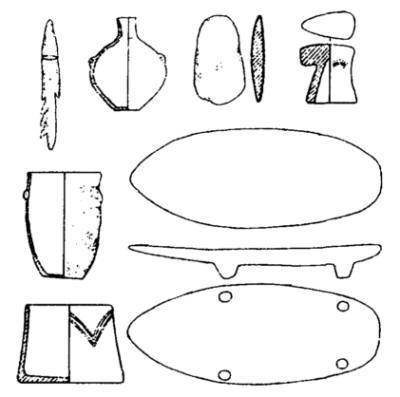
Figure 20 Cishan Culture pottery and stone tools
Cishan found two house foundations, both of which are semi-crypt buildings.
Early Neolithic cultures. It was first discovered in Peiligang, Xinzheng County, Henan Province in 1977.Mainly distributed in central Henan, and also found in northern and southern Henan.According to radiocarbon dating (uncorrected), it is about 7500-6900 years ago.
Agriculture is its main production sector.The main crop is millet, and the main production tools are stone sickles, shovels, and millstones, among which the toothed stone sickles and four-legged nearly shoe-sole-shaped millstones are the most characteristic.In addition, it raises pigs and dogs, and concurrently engages in fishing, hunting and gathering.The pottery is handmade, and it is mostly built with clay strips.Clay pottery is the main type, followed by sand pottery. Clay pottery has more plain surfaces, and some sand pottery is decorated with grate dots, arc grate patterns, scratch patterns, nail patterns and milk ding patterns.The types of utensils include cups, bowls, plates, bowls, three-legged bowls, two-eared pots, three-legged pots, deep-bellied pots, tripods, beans, spoons, and lids, etc. (Figure 21).There are two kinds of house sites, circular and square, both of which are small, with sloped or stepped doorways.
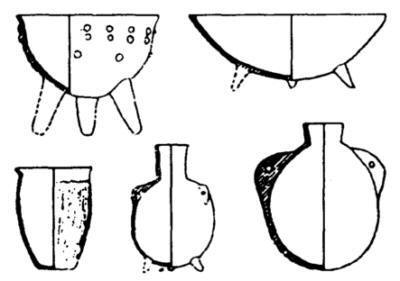
Figure 21 Pottery of the Peiligang Culture
In the Jiahu site belonging to the Peiligang culture, more than 30 house sites and more than 300 tombs were found. A batch of bone flutes with seven sound holes were unearthed. significance.
Neolithic culture.It is named after the ruins of Yangshao Village, Mianchi County, Henan Province.Its distribution range is wide, from eastern Henan to the east, to Gansu and Qinghai junctions in the west, to the Great Wall and the Hetao area in the north, and to northwest Hubei in the south.According to radiocarbon dating and correction, the age is about 7000-5000 years ago.
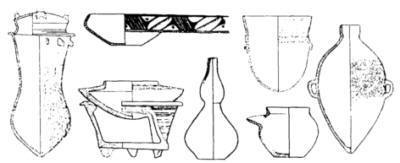
Figure 22 Yangshao Culture Pottery
Yangshao culture can be divided into different types according to the differences of regions and times within its wide distribution range.Their general characteristics are: the pottery is mainly clay or sandy red pottery, and the clay pottery is mostly painted with black-colored geometric patterns or animal and plant patterns (Figure 22).Most of the stone tools were ground, including knives, axes, adzes, chisels, arrowheads, spinning wheels, etc., and some were ground stone tools.In addition, there are well-ground bone tools.The Yangshao people are mainly engaged in the dryland agricultural production of millet and millet, raising pigs, dogs and other livestock, and concurrently engaged in gathering, fishing and hunting.Due to the differences in age and region, their residences reflect diversity. In the early days, most of them were cave-style buildings, and the village layout was centripetal. Townhouse.Yangshao people were buried in public cemeteries after death, and the tombs were arranged in an orderly manner, reflecting a blood relationship.
Late Neolithic cultures.Mainly distributed in western Henan, northern Henan and eastern Henan.It can be divided into three types: Wangwan Phase III, Hougang Phase II and Zaolutai.According to radiocarbon dating and correction, the age is about 4600-4000 years ago.
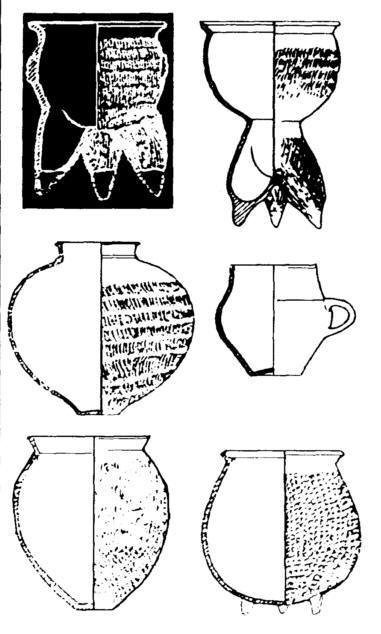
Figure 23 Pottery of Longshan Culture in Henan
The third phase of Wangwan is named after the Wangwan site in Luoyang. The pottery is mostly clay or gray pottery with sand, usually decorated with basket and checkered patterns.Among the production tools, shouldered stone shovels, stone sickles, clam sickles, and perforated stone knives are the most characteristic.Agriculture has developed greatly, raising livestock and concurrently engaged in fishing, hunting and gathering.The second phase of Hougang is named after the site of Hougang in Anyang.The pottery is mostly gray pottery, and Jomon is common (Figure 23).The production tools are mostly rectangular stone knives, as well as bone and clam tools.The social economy is dominated by agricultural production, and concurrently engaged in livestock breeding, fishing, hunting and gathering.Zaolutai type is also called Wangyoufang type.The pottery is mainly wheel-made gray pottery, with basket and checkered patterns common.Half-moon-shaped stone knives, abundant clamware and net pendants are its important cultural features.The social economy is dominated by agriculture, and fishing and gathering play an important role.
It is also known as the second phase of Hakkazhuang culture.Late Neolithic cultures.Mainly distributed in the Jing and Wei basins.According to radiocarbon dating and correction, the age is about 4300-4000 years ago.
Shaanxi Longshan culture has a group of unique pottery groups, mostly argillaceous gray pottery, mainly decorated with basket patterns or rope patterns, and the bundled additional pile patterns are the only ones in this culture. The bag feet of the bag feet are processed by the internal mold method.Production tools include stone tools, bone tools and pottery.In addition, jade ornaments and oracle bones related to sacrifices were unearthed.Agriculture plays a dominant role in the social economy, and livestock is also raised. Fishing, hunting and gathering are also important production sectors.The house sites are all semi-crypt buildings, and the two "Lu"-shaped double-connected house sites are quite special.
(see Taosi Ruins)
Early Neolithic cultures.It is named after the site of Liguanzhuang after Linzi, Zibo, Shandong Province.Its age is about 8000 years ago.
The pottery of the Houli culture is all sand-filled pottery, and a few mica, mainly including kettles, basins, bowls, bowls, jars, and bowls, among which the deep-bellied and round-bottomed kettles are representative utensils.There are few other stones, bones, horns, clam tools, mainly stone hammers, axes, shovels, whetstones, grinding discs, grinding rods, feet, scrapers, pointed tools and stone cores, bone, horny arrowheads, cones , darts, daggers, pikes, etc., as well as clam knives and clam sickles.The living conditions of the Hou Li people are not very clear. They should live in semi-crypt or shallow cave-style houses, and use vertical cave-style pottery kilns to burn pottery.At that time, there was already agricultural production, but the gathering, fishing and hunting economy still played an important role.After death, they are buried in a planned clan cemetery.
Early Neolithic cultures.It is named after the Beixin Site in Teng County, Shandong Province.It is mainly distributed in the central and southern mountainous areas around Shandong.According to radiocarbon dating and correction, the age is about 7300-6100 years ago.
The pottery group of this culture is very characteristic, mainly including sandy yellow-brown pottery, red pottery and red-brown pottery, with well-developed pile patterns, and common vessels such as tripods and kettles.Among the stone tools, there are a certain number of beaten products, and the shapes are regular.Bones, horns, teeth, and mussels are abundant.Beixin people usually live on the ground, and their social economy is mainly based on primitive agriculture. At the same time, they raise chickens, pigs and other livestock, and the gathering and hunting economy also accounts for a certain proportion.
Neolithic culture.It is named after the Dawenkou site in Tai'an County, Shandong Province.It is mainly distributed in the area around Mount Tai, from the shore of the Yellow Sea in the east, to the eastern part of the Luxi Plain in the west, to the south coast of the Bohai Sea in the north, and to the Huaibei area of Jiangsu in the south.In addition, it is also found in Henan and northern Anhui.According to radiocarbon dating and correction, the age is about 6300-4500 years ago.
Dawenkou culture has its own distinctive characteristics. Dawenkou people are prevalent in the customs of artificial deformation of the occipital bone, extraction of upper side incisors, and mouth stone balls.Sandy or muddy red pottery is mostly seen in pottery, and hard white pottery appeared in the late period. The decorations are often pierced, scratched, additional piles, baskets, as well as painted pottery and vermilion painting. Beans, cups, 鬶 [gui gauge], pots, bottles, back pots and Dakouzun, etc. (Fig. 24).The stone tools were exquisitely polished, and after the middle period, well-made jade items appeared, mainly including axes, knives, shovels, adzes, chisels, jade shovels and other decorations.In addition, Dawenkou people also made various bone and tooth tools or decorations, such as needles, bone tubes, bone bead strings, darts, fishhooks, etc.They are engaged in primitive agricultural production mainly planting millet, raising pigs, dogs, cattle, chickens and other domestic animals, while fishing and hunting economy is also an important production sector for them.
At present, no large-scale settlement remains have been found in the Shandong area where the typical Dawenkou culture is distributed, but a settlement site of the late Dawenkou culture has been found in one of its local types, the Yuchi Temple site in Mengcheng, Anhui.It consists of rows of red-fired earthen row houses. These row houses are as many as six in a row, and as few as two are connected. The layout is rigorous, showing high architectural technology.
The burial style of Dawenkou people after death is generally upright burial, but there are also bent down burial, bent-leg burial and secondary burial. In addition, more special burial styles such as head-folding burial and limb-breaking burial have been found.Wooden burial utensils appeared after the middle and late period, and Dakou Zun with various pottery inscriptions were also used in the burial objects of some adult tombs and urn coffins of several children.
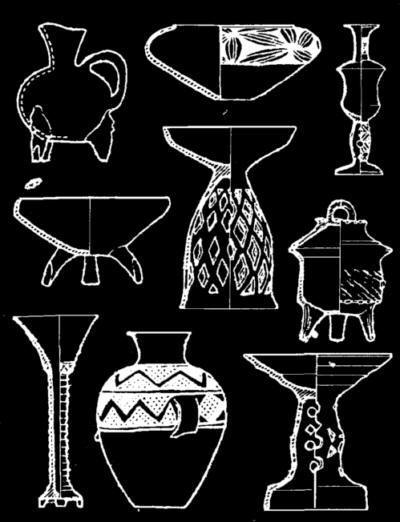
Figure 24 Dawenkou Culture Pottery
Late Neolithic cultures.It is mainly distributed in the eastern and central parts of Shandong Province and the northern part of Jiangsu Province.According to radiocarbon dating and correction, the age is about 4500-4000 years ago.
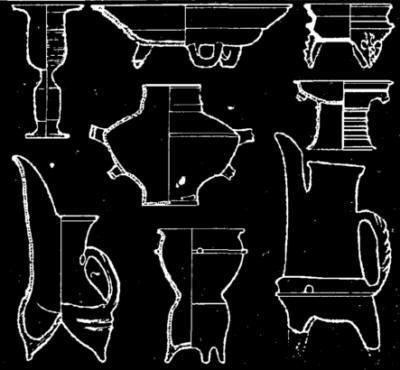
Figure 25 Shandong Longshan Culture Pottery
Shandong Longshan Culture is famous for its black pottery, which was once called "Black Pottery Culture".Pottery is generally made of wheels, and three-legged, ring-footed and bag-footed vessels are well developed. Tripods, 鬶, 盉, 甗 [yanyan], basins, plates, 罍 [lei base], cups are common, and ghost faces are used to foot tripods and eggs. Shell pottery is the most characteristic (Fig. 25).The handicraft industry was developed, producing all kinds of pottery, stone, bone, mussel quality production, living tools and exquisite jade that symbolized status and status.At this time, copper smelting became a new handicraft industry.The living conditions of Longshan people took a leap forward at this time, not only there were villages at all levels from small to large, but also large castles with city walls appeared.It embodies strict social organization structure and strict hierarchy.The burial customs of the Longshan people in Shandong partly inherited the Dawenkou culture, showing a more obvious polarization between the rich and the poor.Based on the above changes, some people think that Shandong Longshan culture may have entered a class society.
Early Neolithic cultures.It is named after the site of Dadiwan in Qin'an County, Gansu Province.Distributed in the Weishui River Basin between Tianshui and Tongguan (also known as Laoguantai Culture or Baijiacun Culture, named after the Laoguantai Site in Hua County, Shaanxi Province and the Baijia Village Site in Lintong County, Shaanxi Province, respectively).According to radiocarbon dating and correction, the age is about 7400-7050 years ago.
The pottery of this culture mainly includes red-brown pottery round-bottomed bowls and three-legged bowls, gray-brown pottery round-bottomed bowls and three-legged bowls, ring-footed bowls, three-legged pots and drum-bellied pots, among which reddish-brown painted pottery is the most characteristic.Stone tools include shovels, axes, knives, adzes, chisels, and grinding sticks.There are also bone spears, awls, arrowheads, needles, clam-made sawtooth sickles, and arc-edged knives.The ancestors of Dadiwan lived a settled life, living in circular semi-crypt shacks, engaged in primitive agricultural production, and the fishing and hunting economy was also an important means of obtaining food.
Cultures of the Late Neolithic Age.It is named after the site of Majiayao in Lintao County, Gansu Province.Mainly distributed in Gansu Province, east to Longdong Mountains, west to Hexi Corridor and northeast Qinghai, north to northern Gansu and southern Ningxia, south to Gannan Mountains and northern Sichuan.According to radiocarbon dating and correction, the age is about 5300-4050 years ago.
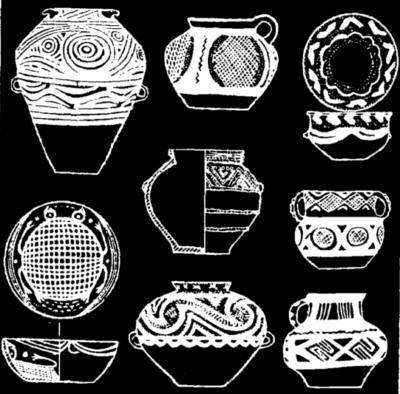
Figure 26 Majiayao Culture Pottery
According to the difference between morning and evening, Majiayao culture can be divided into four types: Shilingxia, Majiayao, Banshan and Machang.Their common feature is the well-developed painted pottery (Figure 26).Production tools include stone sickles, arrowheads, grinding discs, grinding rods, axes, chisels, adzes, bone arrowheads, pottery knives, etc. In addition, copper knives and broken copper pieces were also found.Majiayao people are mainly engaged in dry farming such as planting millet and millet, and concurrently engaged in livestock breeding and hunting.
Cultures from the Late Neolithic to the Early Bronze Age.It is named after the Qijiaping ruins in Guanghe County, Gansu Province.It is mainly distributed in the upper reaches of Taohe River, Daxia River and Weihe River in Gansu Province and Huangshui River Basin in Qinghai Province.According to radiocarbon dating and correction, the early age is about 4000 years ago.
The Qi family lived a primitive agricultural life mainly planting millet and settling down, and concurrently engaged in livestock breeding and hunting economy.Most of the pottery is sandy reddish-brown pottery and clay red pottery, with a small amount of painted pottery.Among the production tools, stone tools are mostly ground with relatively hard jade materials, and bone tools are also important production tools of the Qi family.At this time, copper smelting became a new handicraft project. Bronze wares included red copper or bronze knives, chisels, rings, daggers, axes, bubbles, mirrors and decorations.Most of the houses of the Qi family are square and semi-crypt buildings, some of which are paved with white gray surfaces, and there are cellars for storage around the house site.They have their own religious beliefs, and found stone circle sacrificial places and oracle bones and other sacrificial supplies.It is generally believed that the Qijia culture is in the stage of military democracy when the primitive society is about to collapse.
Early Neolithic cultures.It is named after the Chengbeixi site in Zhicheng City, Hubei Province.At present, it is divided into two types: Chengbeixi and Zaoshi.The Chengbeixi type is mainly distributed in the southwest of Hubei Province, while the Zaoshi type is distributed in the west and north of Dongting Lake.The age is speculated to be about 7000 years ago.
The pottery of the Chengbeixi type is mainly red-brown pottery with sand and more charcoal pottery. The main types of pottery are kettle, bowl, support, ring-foot plate, and pot.There are abundant stone implements, many of which are hammered and carved, including axes, adzes, balls, net pendants, stone flakes, stone strips, and disk-shaped implements.Zaoshi type pottery is still dominated by reddish-brown pottery, and there are very few charcoal pottery.Stone tools are divided into three types: fine flint tools, hammered stone tools and ground stone tools, and the technology of drilling holes has been mastered.People in Chengbeixi have started rice farming, but fishing, hunting and gathering still play an important role.
Neolithic culture.It is named after the Daxi site in Wushan County, Sichuan Province.It is mainly distributed in the area from the central and southern Hubei in the east, to the north shore of Dongting Lake in the south, to eastern Sichuan in the west, and to the coast of the upper reaches of the Han River in the north.According to radiocarbon dating and correction, the age is about 6400-5300 years ago.
Red-clothed pottery is prevalent in Daxi culture, and the common types of utensils include cauldrons, slanted edge jars, small-mouth straight-necked jars, jugs, basins, bowls, beans, gui, ring-footed plates, ring-footed bowls, cylindrical bottles, curved-bellied cups, and utensils. Seats and lids, etc. (Figure 27), as well as pottery balls and pottery ring balls.Gui-shaped stone chisels are common among stone tools, as well as shovels, adzes, hoes and giant stone axes.The social economy of the Daxi people is mainly based on rice farming, and they also raise pigs, dogs, chickens, cattle, sheep and other domestic animals. Fishing, hunting and gathering are the auxiliary means for them to obtain food.Daxi people have mastered relatively high construction technology. Their houses are grilled by fire, and some of them are built with sprinklers and verandas to prevent moisture, wind and rain, and heat insulation.After their death, most of them were buried with upright limbs, mainly with straight limbs on their backs. In addition, there were also found burials with bent limbs. Squatting burial is the most special.
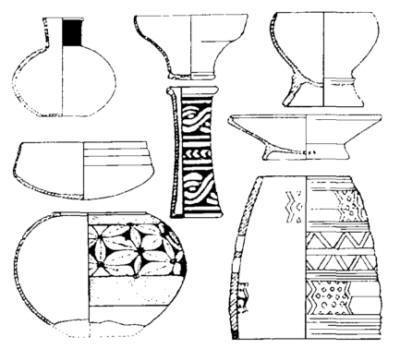
Figure 27 Daxi Culture Pottery
Neolithic culture.With the Jianghan Plain as the center, it is mainly distributed in the Hubei area.According to radiocarbon dating, the age is about 5000-4600 years ago.
The pottery of the Qujialing culture is mostly muddy black pottery or muddy gray pottery. The decorations are often convex strings and hollow holes. The most characteristic feature of painted pottery is thin-bodied blooming. There is also a small amount of Zhu painted pottery. , beans, pots, pots, bowls, basins, bowls, three-legged dishes, cups, jars, etc. Among them, the well-developed ring-footed and concave-bottomed utensils are important features that distinguish this culture from other cultures.Production tools include stone axes, stone adzes, stone chisels, stone arrowheads and painted pottery spinning wheels.Other relics include hollow pottery balls and faience balls (Fig. 28).Its economic life is dominated by agriculture, mainly rice cultivation, and concurrently engaged in fishing, hunting and gathering.
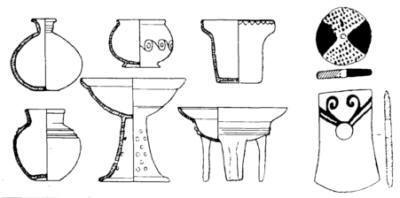
Figure 28 Pottery and Stone Tools of the Qujialing Culture
The living conditions of Qujialing people are relatively superior. They are generally square or rectangular ground buildings, and there are many connected row houses.In terms of construction technology, excavation is used to build foundations, and clay or grass mud is mixed with burnt soil fragments to build walls. The living surface is smeared with fine mud and grilled to prevent moisture.It has been suggested that this form of architecture is a reflection of patriarchal society.
In the burial customs of the Qujialing people, adults are mostly buried with one person upright or with a small number of bent limbs, without burial utensils.Children are mostly buried in urn coffins.
Cultures of the Late Neolithic Age.It is named after the Shijiahe site in Tianmen City, Hubei Province.Centered on the Jianghan Plain.Several local types can be distinguished within its range of distribution.
People in Shijiahe are mainly engaged in rice farming, and concurrently engage in livestock breeding and fishing and hunting economy.The pottery is mainly gray pottery, black leather pottery and red brown pottery, mostly decorated with basket patterns. and notch cutter.The production tools include polished stone tools, bone tools and pottery. The stone tools are finely ground, including axes, hoes, shovels, knives, sickles, chisels, arrowheads, spears, net pendants, spinning wheels, etc.In addition, there are decorations such as bone rods, stone rings, stone pipes, stone beads, pottery rings and small pieces of jade.Pottery sculptures of people, birds and animals are treasures of primitive plastic arts.At this time, the Shijiahe people had begun to build castle-style buildings and held large-scale sacrificial activities.
Neolithic culture.It is named after the Hemudu site in Yuyao County, Zhejiang Province.It is mainly distributed in the Ningshao Plain and reaches the Zhoushan Islands in the east.According to radiocarbon dating and correction, the age is about 7000-5300 years ago.
Carbon black pottery, bone, wood processing skills and developed rice farming are important features of Hemudu culture.Pottery mainly includes cauldrons, jars, bowls, plates, scorpions, and legs (Fig. 29).Bone implements are represented by pike, and there are also arrowheads, needles, whistles and so on.The wood processing technology is mainly manifested in a large number of mortise and tenon structures, the use of tongue and groove and large dry fence construction, in addition to the earliest known wooden tire lacquerware.In addition to rice farming, the Hemudu people also engage in livestock breeding, fishing and hunting.
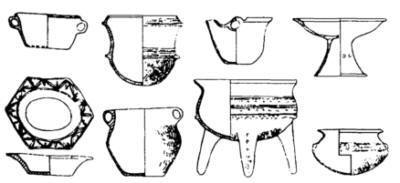
Figure 29 Pottery of Hemudu Culture
The discovery of the Hemudu culture shows that in the ancient times of our country, the Yangtze River Basin had a splendid culture, and it was also an important source of Chinese civilization.
Neolithic culture.It is named after the Majiabang ruins in Jiaxing County, Zhejiang Province.It is mainly distributed in the Taihu Lake area, reaching the Qiantang River in the south and Changzhou, Jiangsu in the northwest.According to radiocarbon dating and correction, the age is about 7000-6000 years ago.
The pottery of the Majiabang Culture is mainly sandy or muddy red pottery, such as cauldrons, tripods, beans, pots, urns, basins, bowls, etc., usually with plain noodles.The stone tools are exquisitely polished, mainly adzes.In addition, Majiabang people also mastered the technology of wood processing and jade making. The jade huang and jade ring [juejue] they made later became traditional Chinese decorations.It is worth mentioning that three pieces of ribbed cloth with flowered wefts were found in the Caoxieshan site of this culture, which are the earliest textile objects in China.At this time, people lived a settled life dominated by agricultural production, planting japonica and indica rice, raising livestock, fishing, and hunting.People lived in square or circular chambers, and after death, they were buried in a special bent-over burial.
(See Songze Site, Sidun Site)
Middle Neolithic culture.It is named after the Xuejiagang site in Qianshan County, Anhui Province.It is mainly distributed in the north of the Yangtze River, the south of the Dabie Mountains, the west of Chaohu Lake, and the east of Susong and Huangmei.The age is about 5700-4900 years ago.
The pottery of this culture is mostly gray and black pottery, with well-developed tripods, including three types of tripods, 鬶, and 盉, and the main container is pots, with various shapes.Among the stone tools, porous stone knives are the most representative, as well as shovels, adzes, chisels, axes, axes and small ornaments.In addition, the exquisite processing of jade is also one of the characteristics of this culture.
Neolithic culture.It is named after the Liangzhu site in Yuhang County, Zhejiang Province.It is mainly distributed in the Taihu Lake area, from the Qiantang River in the south to Changzhou, Jiangsu in the northwest.According to radiocarbon dating, the age is about 5300-4200 years ago.
Liangzhu culture is famous for its unique pottery group, exquisite jade and silk and linen fabrics.The pottery is mainly gray black pottery with fine sand or muddy black leather pottery, and it is mostly made of wheels, with plain surfaces mainly polished, and a small number of utensils are decorated with carved patterns or hollow holes.The most common types of utensils are tripods, bamboo handles, pots with piercing ears, plates and cups with flow.The craftsmanship of jadeware processing is relatively high, and the types of jadeware include beads, pipes, pendants, jue, yuan, huang, bracelets, cong, cicadas, and bi.The body of the vessel is mostly decorated with complicated and exquisite patterns (Fig. 30).In the Qianshanyang site of this culture, silkworm silk fabrics and ramie fabrics with plain weave were also found.In addition, the techniques of making wooden crafts such as bamboo weaving and oars are also mastered by Liangzhu people.
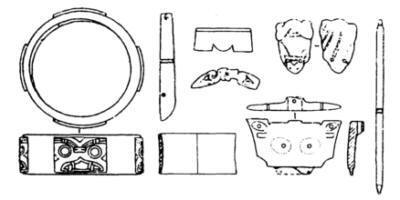
Figure 30 Liangzhu culture jade
Liangzhu people are engaged in agricultural production mainly planting japonica rice and indica rice, and have advanced agricultural production tools, including new tools such as stone plowshares and stone earth breakers.The location of their residence is not very clear, but it was found that there were stilt buildings and piles of burnt soil on large earthen platforms, and some wells were dug near the residences.
The tombs of the Liangzhu Culture are very rich in data. According to their scale and the number of burial objects, they can be divided into three types: large, medium and small. Large and medium-sized tombs also exist in combination with sacrificial sites, which shows that the social division between rich and poor was obvious at that time. Clan society Begins to disintegrate, at least in its late stages the dawn of civilization.
Early Neolithic cultures.It is named after the ruins of Xinglongwa, Aohan Banner, Inner Mongolia.It is mainly distributed in the West Liaohe River, Daling River Basin to the southern foot of Yanshan Mountain, and the periphery of Keshiketeng Banner, Linxi County, Balin Zuo Banner, Fuxin, Liaoning, Sanhe, Hebei and other places in Inner Mongolia.According to radiocarbon dating and correction, the age is about 8200-7400 years ago.

Figure 31 Pottery and stone tools of the Xinglongwa Culture
The pottery of the Xinglongwa culture is all sand-filled pottery, which is low-fired, loose in texture, and simple in shape, and cylindrical pots are common.Most of the stone tools were ground stone tools, and there were also ground stone shovels, axes, millstones, and millsticks (Fig. 31).Bone tools include chisels, daggers, needles, fish darts, etc. There are also compound tools made of bone stems and stone blades.The jades of this culture are the earliest jades seen in my country.At that time, agriculture had developed to a certain extent, but the fishing and hunting economy still played an important role.People live in rectangular or square semi-crypt houses arranged in rows in a circular moat to form a village.The burial customs of Xinglongwa people after death are quite special. Some people are buried in the living room, and some of them have special practices such as burial with humans and pigs or burial with jade, which shows the particularity of the identity of the tomb owner.
(See Xinle Ruins)
Early Neolithic cultures.It is named after the site of Shangzhai in Pinggu County, Beijing.Mainly distributed in Beijing and adjacent areas.According to radiocarbon dating and correction, the age is about 7400-6300 years ago.
The pottery of this culture is all handmade, mainly sand and steatite pottery, and the types of vessels are simple, such as deep-bellied pots, bowls, basins, bowls, cups, cups, boat-shaped vessels, brackets, and pottery sculptures.Most of the stone tools are large-scale stone tools that were hammered, cut or polished, including disc-shaped utensils, ax-shaped utensils, anvils, shovels, grinding sticks, grinding discs, and hoe-shaped utensils.Microlithic tools include arrowheads, pointed tools, scrapers, stone leaves, etc., as well as throwing balls, projectiles, and carvings.Shangzhai people lived a settled primitive agricultural life, and fishing, hunting, gathering, and livestock raising also accounted for a certain proportion, and they had their own primitive religious beliefs or totem worship.
Neolithic culture.It is named after the site of Zhaobaogou in Aohan Banner, Inner Mongolia.It is mainly distributed in the south of the Xilamulun River and the north of the southern foot of Yanshan Mountain.According to radiocarbon dating and correction, the age is about 7200-6800 years ago.
The pottery used by Zhaobaogou people is mostly sandy brown pottery, mainly decorated with embossed geometric patterns, zigzag patterns, and animal patterns.Stone tools are divided into four types: grinding, cutting, hammering and pressing, including axes, plows, chisels, rings, millstones, millsticks, millstones and fine stone tools.Fewer bones.Their residences are square or rectangular semi-crypt buildings with rounded corners. There is a square kitchen pit in the middle of the room, with an area of about 20 square meters, and the largest ones reach 100 square meters.
(See Xiaozhushan Ruins)
(see Xinkailiu Ruins)
Neolithic culture.Distributed in southeastern Inner Mongolia, western Liaoning, northern Hebei, and also found in Jilin.According to radiocarbon dating and correction, the age is about 5500 years ago.
The stone tools of this culture are most characterized by the tobacco leaf or grass shoe-shaped pike, and the double-hole stone knife shaped by laurel leaves, as well as chopping tools, grinding discs, grinding sticks, arrowheads and round scrapers.Handmade pottery, there are two kinds of sand and clay.Sand-filled pottery is mainly brown, and the types of pottery include large-mouthed deep-bellied jars, folded-mouthed deep-bellied jars, and oblique-mouthed jars.Clay pottery is mostly red, and its shapes include bowls, jars, basins, and urns, and its decorations are mostly black or purple patterns with parallel lines, triangles, and scales (Fig. 32).In addition, the Hongshan Culture produced exquisite jade wares and various pottery figurines.
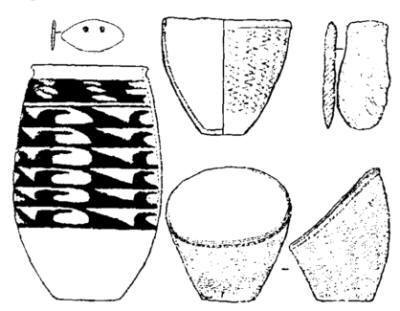
Figure 32 Hongshan Culture pottery and stone tools
The houses lived by the ancestors in Hongshan are square and semi-cave buildings, which can be divided into large and small. There is a scoop-shaped stove in the middle of the house.They can also build single-chamber or connected-chamber kilns, burn various pottery products, live a sedentary life mainly in primitive agricultural production, and at the same time, engage in some animal husbandry, fishing and hunting production.
Late Neolithic cultures.It is named after the site of Fuhegoumen in Bahrain Left Banner, Inner Mongolia.According to radiocarbon dating and correction, the age is about 5350 years ago.
The pottery of the Fuhe Culture is mostly sandy brown pottery, the main decoration is the embossed "Zhi" pattern, and the representative utensils are large-mouthed cylindrical jars.Most of the large-scale stone tools are hammered, and the hoes, adzes, chisels, etc. are finely processed and full of characteristics.And there are bone tools and oracle bones.Houses of Fuhe Culture can be divided into two types: square or circular. Generally, there is a square stove in the middle of the house.The natural environment at that time was a mountain forest type, people lived a settled life, and had primitive agriculture, but the fishing and hunting economy still played an important role.
Neolithic culture.It is named after the Paomaling site in Shanbei Village, Xiushui County, Jiangxi Province.It is mainly distributed around Poyang Lake and the middle and lower reaches of Ganjiang River. According to radiocarbon dating and correction, the age is about 4800 years ago.
The residences of Shanbei people are rectangular or circular ground buildings with rounded corners.They mostly use sand-filled red pottery, including tripods, goblets, pots, beans, jugs, and gui [gui ghosts], etc.The most distinctive stone tools are thick segmented stone adzes, half-moon, comb-shaped or rectangular stone knives.At that time, people were engaged in primitive agricultural production based on rice.
(See Dadikeng Ruins)
Late Neolithic cultures.It is named after the ruins of Tanshi Mountain, Hengxin Township, Minhou County, Fujian Province.Mainly distributed in the lower reaches of the Minjiang River.According to thermoluminescence dating, the age is about 4300-4200 years ago.
The pottery is mainly red or gray pottery, including cauldrons, tripods, pots, jars, beans, gui and cups, and a small amount of painted pottery.Stone tools are represented by stone adzes with triangular cross-sections.Judging from the unearthed relics and relics, Tanshishan people already had agriculture, and the fishing and hunting economy was relatively developed.The discovery of joint burials of men and women in this culture is a reflection of the original patriarchal system at that time.
Late Neolithic to Early Bronze Age cultures.It is named after the Yuanshan Site in Taipei County, Taiwan Province.Mainly distributed in the Taipei Basin.According to radiocarbon dating and correction, the age is about 4400-3100 years ago.
The pottery of this culture is mainly brown-gray fine sand pottery, some of which are painted with red color.Production tools include stone and bone tools, and stone tools include hoes, shovels, axes, and arrowheads.Bronze products appeared in the late period.
Cultures from the Late Neolithic to the Iron Age.Named after the Fengbitou site in Kaohsiung, Taiwan.It is mainly distributed in the central part of the west coast of Taiwan.Its origin is about 4500-3500 years ago.
The Fengbitou culture can be divided into three types from early to late. The early stage is characterized by red pottery, and pottery includes tripods, pots, beans, bottles, basins, and bowls.Most of the stone tools are ground, including hoes, boot-shaped knives, half-moon-shaped piercing knives, millstones, spears, and arrowheads.Mainly engaged in primitive agriculture, concurrently engaged in fishing and hunting.In the middle period, it is characterized by black pottery, and rice is mainly grown.The late period is characterized by prints and depictions of gray and black pottery, and has entered the Iron Age.
Late Neolithic cultures.It is named after the Beinan site in Taitung County, Taiwan Province.Mainly distributed in eastern Taiwan.The age is about 3000-2000 years ago.
The pottery of the Puyuma people is mostly fine-sand pottery, which is handmade, and some of them are wheel repaired. The main types of utensils are pots, bottles, bowls, basins, spoons, plates, beans, lids, spoons, spinning wheels, rings, mallets, pottery sculptures, etc. .There are many stone tools, including axes, hoes, sickles, knives, pestles, spears, arrowheads, needles, drills, net pendants, adzes, chisels, sticks, hammers, whetstones, axes and wheels.There are also jade objects.The funerary slate slate coffins of the Puyuma people are one of the important features of this culture.Large burials have funerary objects, and some skeletons have tooth extractions.
(See Baiyang Village Ruins)
(See Karo Ruins)

Figure 20 Cishan Culture pottery and stone tools

Figure 21 Pottery of the Peiligang Culture

Figure 22 Yangshao Culture Pottery

Figure 23 Pottery of Longshan Culture in Henan

Figure 24 Dawenkou Culture Pottery

Figure 25 Shandong Longshan Culture Pottery

Figure 26 Majiayao Culture Pottery

Figure 27 Daxi Culture Pottery

Figure 28 Pottery and Stone Tools of the Qujialing Culture

Figure 29 Pottery of Hemudu Culture

Figure 30 Liangzhu culture jade

Figure 31 Pottery and stone tools of the Xinglongwa Culture

Figure 32 Hongshan Culture pottery and stone tools
